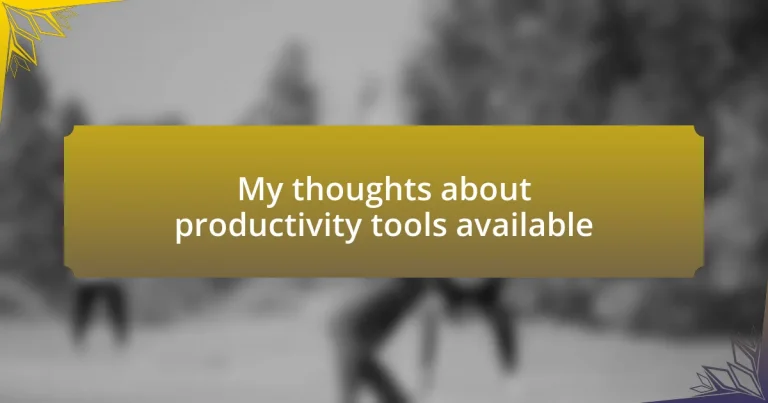Key takeaways:
- Productivity tools enhance time management, prioritization, collaboration, focus, and customization, making work processes more efficient.
- Popular productivity tools include Trello for project management, Todoist for task organization, Evernote for note-taking, and Slack for real-time communication.
- Key features to evaluate in productivity tools are usability, integration capabilities, and reporting functions, which help refine productivity approaches.
- For individuals, tools like Todoist, Notion, and Trello facilitate task management and visual planning, while teams benefit from tools such as Slack, Asana, and Google Workspace for collaboration.
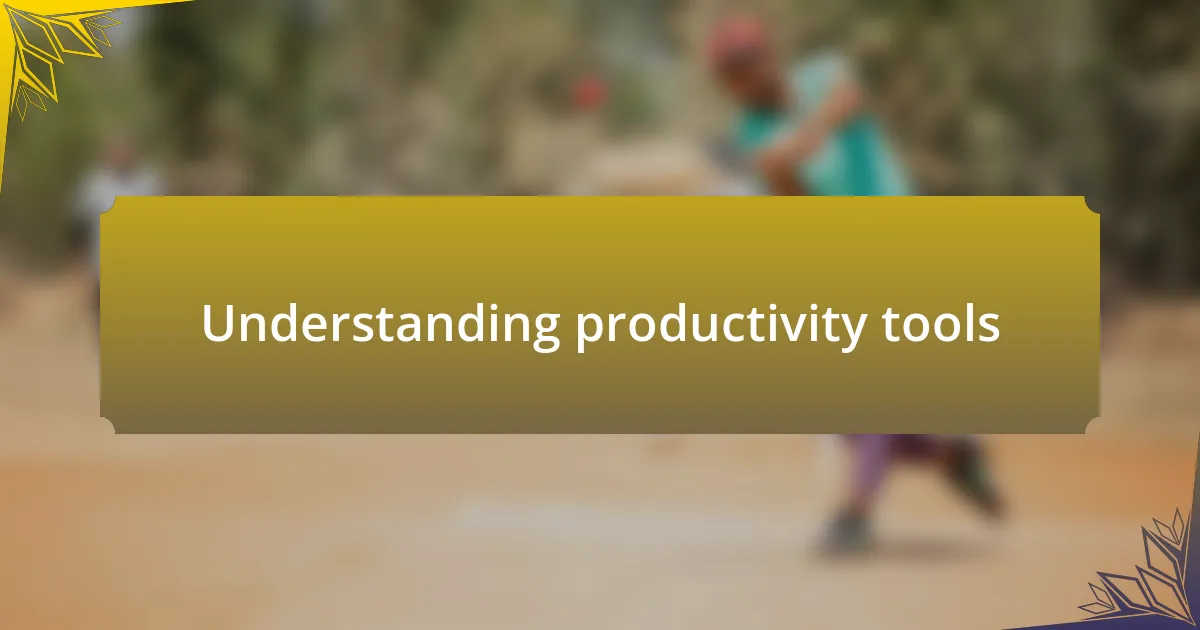
Understanding productivity tools
Productivity tools encompass a wide range of applications and strategies designed to help individuals manage their time and tasks more effectively. I remember when I first stumbled upon a task management app; it felt like finding a treasure chest of possibilities. Suddenly, my chaotic list of to-dos transformed into a structured, manageable plan, making me wonder how I ever functioned without such technology.
The beauty of these tools lies not just in their functionality, but in how they cater to diverse working styles. For example, some people thrive on lists, while others prefer visual boards that stimulate their creativity. Have you ever noticed how a simple change in your workflow can dramatically influence your motivation? That realization shifted my perspective on productivity entirely; it’s not just about getting things done, but about doing them in a way that resonates with who I am.
Moreover, understanding the purpose of each tool is crucial. I often find myself gravitating towards tools that promote collaboration, particularly in team settings. It’s fascinating to see how everyone’s input can shape a project, much like a potluck dinner where each dish adds a unique flavor. This connection among team members can serve as a powerful reminder that productivity is not solely a solitary endeavor.
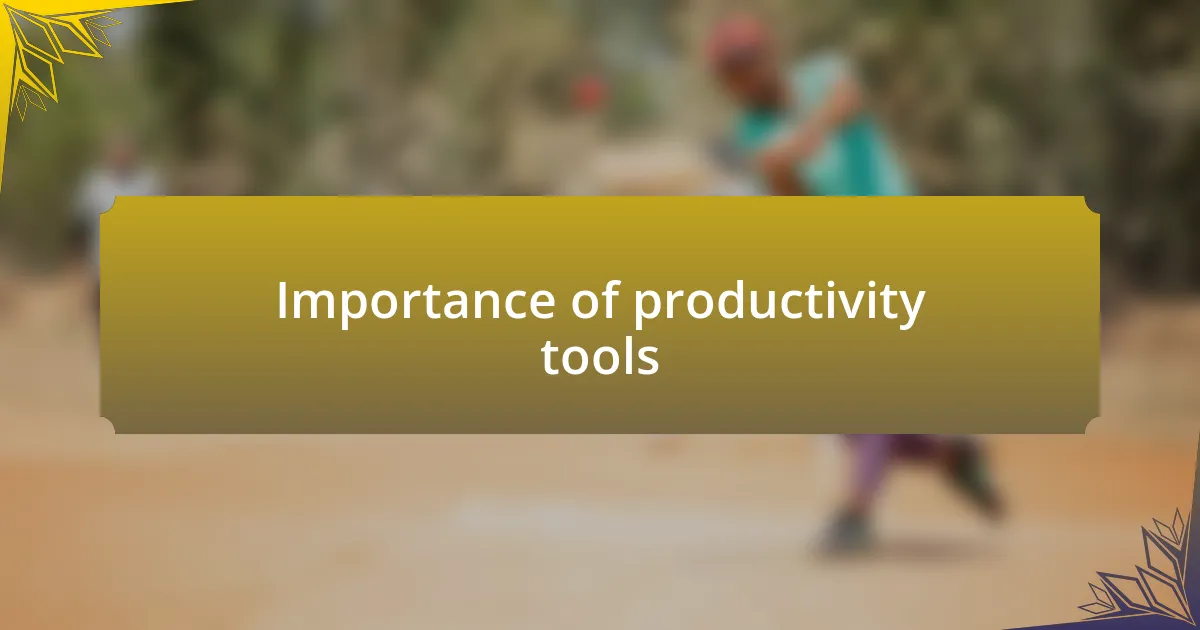
Importance of productivity tools
Productivity tools are essential for maximizing efficiency and keeping us focused on our goals. I can’t recall how many times I found myself drowning in tasks, struggling to prioritize. Using a calendar app changed that for me; I could see my week at a glance, allowing me to allocate time blocks for deep work and breaks. This clarity not only improved my output but also eased my anxiety.
Here are a few reasons why productivity tools matter:
- Time Management: They help streamline daily tasks and allocate time efficiently.
- Prioritization: Tools allow us to rank tasks by urgency and importance, ensuring critical items aren’t overlooked.
- Collaboration: They facilitate better communication and project tracking among team members, creating a shared sense of purpose.
- Focus: Distracting elements can be minimized, providing an environment conducive to concentration.
- Customization: Users can tailor these tools to fit their specific needs, enhancing user experience and effectiveness.
I vividly remember the relief I felt as I started using a project management software that adapted to my workflow instead of constraining it. It was as if I’d taken a deep breath after being under water for too long. Just knowing I had everything at my fingertips not only boosted my productivity but also gave me a sense of control that I hadn’t had before.
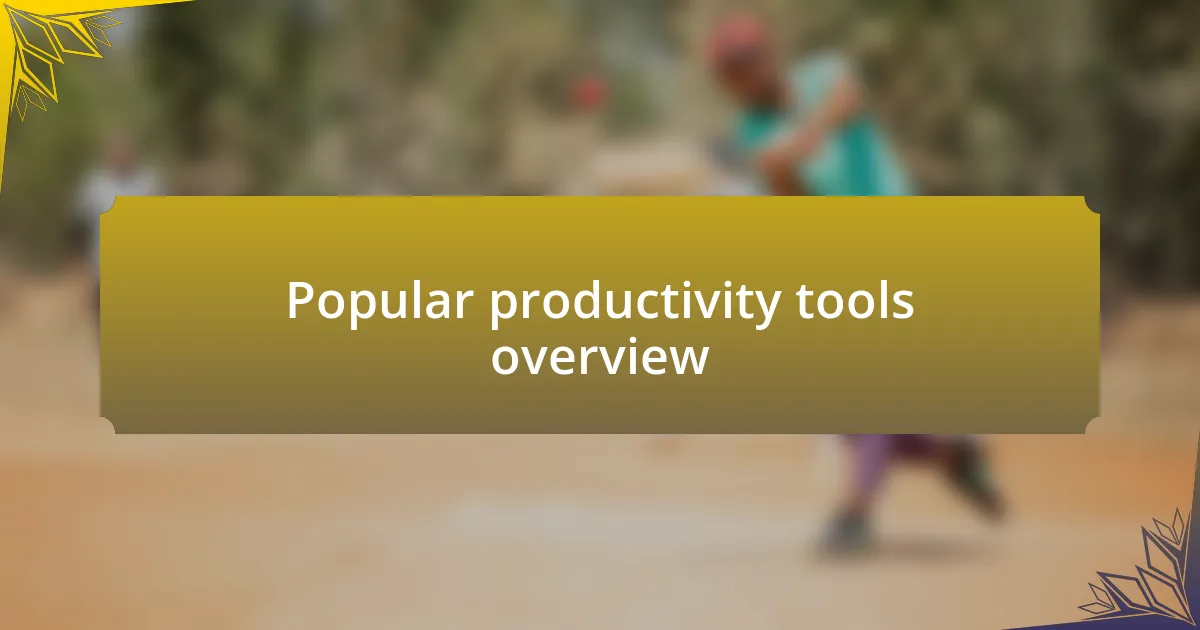
Popular productivity tools overview
When it comes to productivity tools, a range of options stands out, each uniquely designed to cater to different needs. For instance, apps like Trello and Asana excel in project management, allowing users to visually organize tasks on boards. I remember the first time I used Trello; the drag-and-drop functionality made the experience feel less like work and more like playing a strategic game. Each task suddenly morphed into a card that I could move around, giving me a tangible sense of progress that was both rewarding and motivating.
Another popular category is time management tools such as Todoist and Evernote, which help streamline daily tasks and keep track of notes in one place. I was once caught up in a cycle of forgetting important meetings and deadlines until I embraced Evernote. The simplicity of jotting down thoughts and ideas as they came to me meant that I was no longer wrestling with scattered sticky notes and lost reminders. By having everything in one organized space, I significantly reduced my mental clutter, which I didn’t even know I had.
Finally, communication tools like Slack and Microsoft Teams have revolutionized how we collaborate with others, breaking down barriers and fostering real-time discussion. I often recall my initial hesitations about using Slack, but now I can’t imagine working without it. Its channels allow me to engage in focused conversations about different projects while minimizing email overload. This not only streamlines communication but also nurtures a stronger sense of teamwork, allowing me to feel more connected, even in a remote setting.
| Tool | Functionality |
|---|---|
| Trello | Project management with visual boards |
| Todoist | Task organization and scheduling |
| Evernote | Note-taking and information management |
| Slack | Real-time team communication |
| Asana | Task management and collaboration |
| Microsoft Teams | Integrated collaboration and communication |
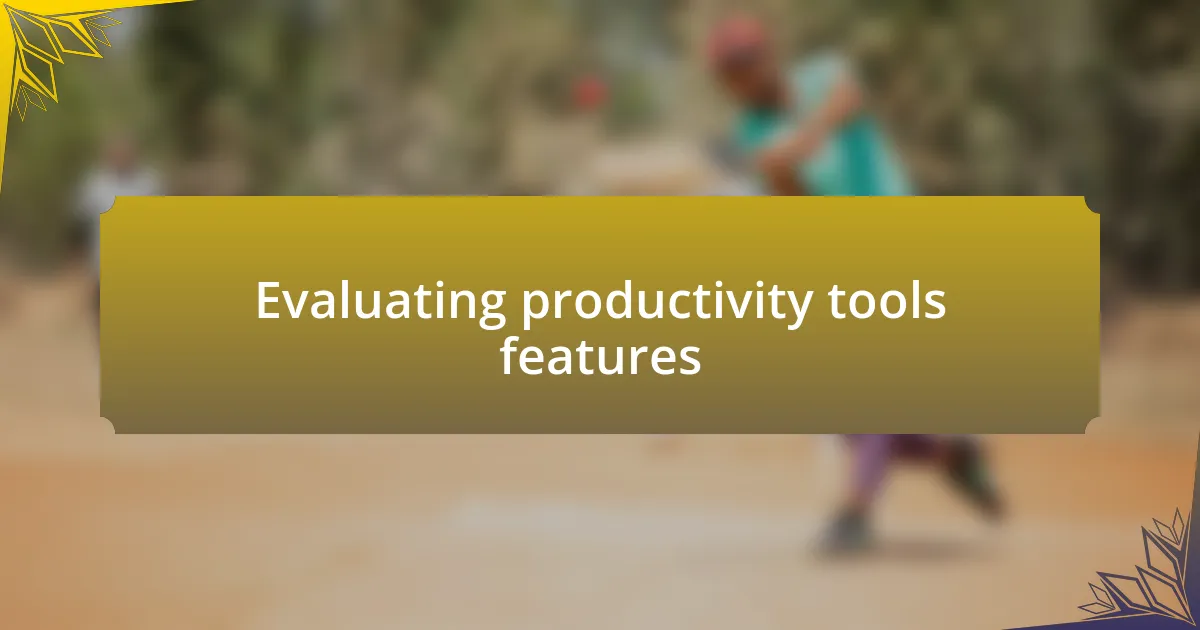
Evaluating productivity tools features
When evaluating productivity tools, I always pay close attention to their user interface and overall usability. There’s nothing more frustrating than diving into a tool only to feel overwhelmed or confused by its layout. For me, an intuitive design is crucial; I remember struggling with a tool that had a cluttered interface, which only drained my motivation instead of boosting my productivity.
Another feature I consider is integration capabilities with other tools I already use. Can it sync with my calendar, email, or other apps? I once found myself drowning in multiple apps that didn’t communicate with each other, which felt like an uphill battle rather than a streamlined experience. Discovering a tool that effortlessly connected my calendar to task management was a game changer; it simplified my daily routine significantly.
Lastly, I reflect on the reporting and analysis features of productivity tools. Being able to track my progress and productivity patterns not only motivates me but also helps me refine my approach. I still remember the first time I saw weekly productivity reports from a time management app I was using—it gave me insights that I couldn’t have anticipated, leading to adjustments that boosted my efficiency. Have you ever wondered how many hours you might be wasting on unproductive tasks? That moment of realization can truly transform your workflow.
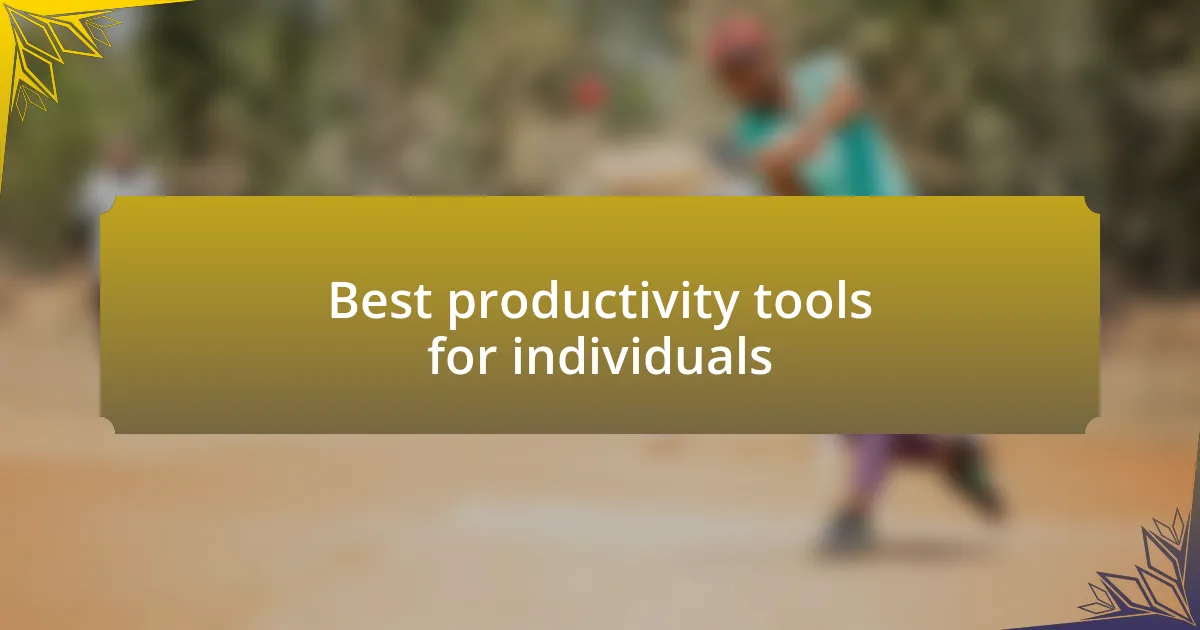
Best productivity tools for individuals
When it comes to productivity tools for individuals, I’ve found that Todoist stands out as a top choice. Its simplicity really resonates with me; I can quickly add tasks and organize them without getting bogged down by unnecessary features. I still recall a time when I was juggling multiple projects, and Todoist helped me sort my tasks into manageable sections, making my workload feel less daunting.
Another tool I swear by is Notion. The versatility it offers is something I appreciate deeply; I can use it as a note-taking app, a project tracker, or even a personal wiki. I remember starting to set up my Notion workspace and feeling a rush of excitement as I customized it to fit my unique needs. This level of customization made my workflows smoother and more enjoyable, almost like creating a personal space where my thoughts could thrive.
Lastly, Trello has been a game changer for my visual planning needs. There’s something satisfying about dragging tasks across boards as they progress from “To Do” to “Done”. I’ll never forget the sense of achievement I felt the day I completed an entire project using Trello; seeing those cards move gave me a tangible sense of progress. Have you ever experienced that joy of checking off a task? It’s a feeling that these tools help cultivate regularly.
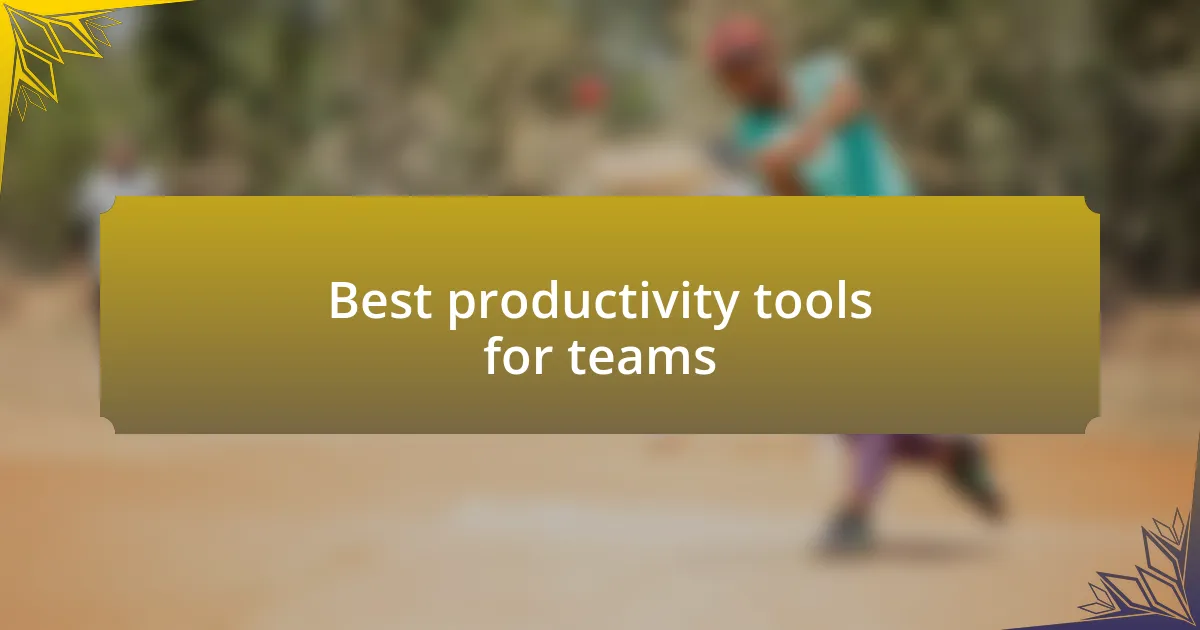
Best productivity tools for teams
When collaborating in a team, Slack proves to be an invaluable tool. Its instant messaging features have transformed how my teams communicate; I fondly remember a project where we were spread across different time zones yet synchronized our efforts seamlessly through Slack’s channels and threads. Can you imagine how chaotic it would have been without that clarity and organization?
Another tool that I’ve found incredibly effective is Asana. Whenever I manage team tasks, Asana helps keep everyone aligned and accountable. It’s memorable to see my colleagues visibly motivated when they receive those notifications about deadlines approaching; it fosters a sense of urgency that I believe translates into productivity. How does your team ensure everyone stays on track with their roles?
Lastly, I can’t overlook the role of Google Workspace in enhancing our collaboration. I still recall a brainstorming session where we all contributed ideas in real-time on a shared Google Doc. That experience not only spurred creativity but also solidified our team’s bond, as everyone felt involved and valued. Have you ever participated in something collaborative like that? It can truly elevate a team’s dynamics.
